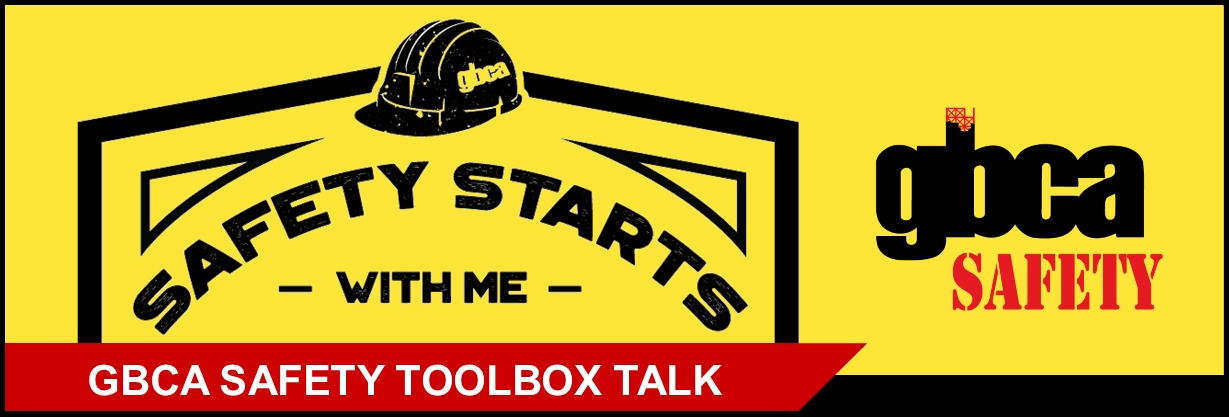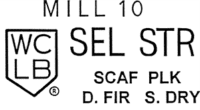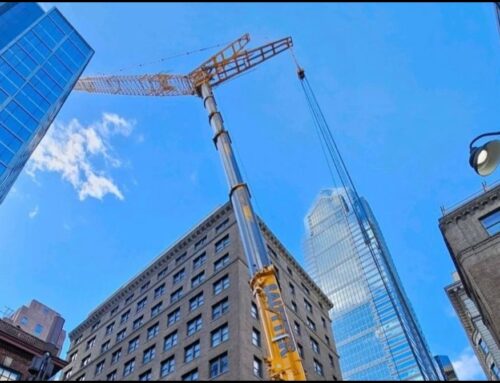This GBCA Safety Toolbox Talk discusses scaffold planking. Get reminders of what to look for in scaffold planks, as well as reminders of the OSHA requirements for spacing scaffold planks. Click below to download the Toolbox Talk as a handout (includes Sign-In Sheet).
Scaffold Planking
Scaffold platforms allow workers to work safely at heights. Many platforms are constructed of wood planks, which must be inspected and maintained to ensure that the work platform is safe. This toolbox talk goes over the conditions workers should review when working on scaffolds.
Scaffold-grade lumber is meant to withstand forces not imposed on ordinary, construction-grade wood (which is only two-thirds the capacity of scaffold-grade). Using construction-grade lumber on a scaffold platform violates OSHA standards and is an unsafe practice that can lead to a deadly incident.
Visually Inspect and Correctly Select Scaffold Planks
All planks used for scaffolds should be inspected before setup as well as before and during use. If a plank is found to no longer meet OSHA standards, it should be removed and replaced.
Scaffold Plank Grade Stamps
- Solid sawn wood used for scaffold planks should be graded by a recognized lumber grading association or an independent lumber inspection agency. These organizations and their grading rules must be certified by the Board of Review of the American Lumber Standard Committee, per the US Department of Commerce.
- Wood approved for use as scaffold planks should have a grade stamp (see examples).
- Grade stamp courtesy of Southern Pine Inspection Bureau
- Grade stamp courtesy of West Coast Lumber Inspection Bureau
BE AWARE: OSHA does NOT inspect lumber. Any scaffold planking stamped “OSHA Approved” is misleading and should not be assumed to meet the standard on the basis of that stamp alone. An inspection agency can claim that its product meets OSHA requirements, but it must still have its own grade stamp.
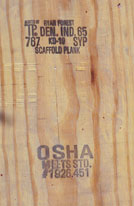
Pictured: Scaffold plank with grade stamps. If the “OSHA” stamp were alone, it would not necessarily meet the standard.
REMINDER: Scaffold planks may still be in service after the grade stamp has faded. Workers should pay attention to the quality and condition of the planking, whether it bears a stamp or not.
Issues to Check for in Scaffold Planks
As wood ages and reacts to usage, it will begin to show checks, splits, and notches. These will vary in degree depending on variables such as the loads a plank has carried, the weather it has been exposed to, and how long it has been in use.
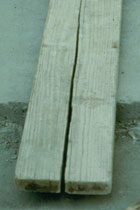
Split in Wood Plank
- Planks with splits (cracks that go clear through the wood) more than a few inches in length should NOT remain in service. They may no longer maintain the necessary load-bearing capacity.

Checks in Wood Plank
- Planks with checks (cracks that are on the surface only and do not go clear through the wood) should be watched over time. The checks may develop into splits over time.

Notches in Wood Plank
- Notches (small checks on the ends of a plank) should be watched over time. They can lengthen and deepen, and eventually become splits.

Accumulated Layers of Paint and Plaster on Wood Plank
- Scaffold planks that have accumulated layers of paint, plaster, etc. are NOT permitted to remain in service. These coatings make it impossible to determine the condition of the planks. Dangerous splits, for example, may be hidden underneath these coatings. [29 CFR 1926.451(b)(9)]
Reusing Scaffold Planks
- If a scaffold plank has been used as a mudsill, it should NOT be returned to service on a platform.
- Moisture from standing water, as well as point-loading from the scaffold legs, may have weakened planks used as mudsills, making them unable to bear the weight that will be placed on them as scaffold planks.
Spacing Requirements for Scaffold Planks
- Each platform unit (e.g., scaffold plank, fabricated plank, fabricated deck, or fabricated platform) shall be installed so that the space between adjacent units and the space between the platform and the uprights is no more than 1 inch (2.5 cm) wide, except where the employer can demonstrate that a wider space is necessary (for example, to fit around uprights when side brackets (outriggers) are used to extend the width of the platform). [1926.451(b)(1)(i)]
- Where the employer makes the demonstration provided for in paragraph (b)(1)(i) of this section, the platform shall be planked or decked as fully as possible and the remaining open space between the platform and the uprights shall not exceed 9 1/2 inches (24.1 cm). [1926.451(b)(1)(ii)]
- Except as provided in paragraphs (b)(3)(i) and (ii) of this section, the front edge of all platforms shall not be more than 14 inches (36 cm) from the face of the work, unless guardrail systems are erected along the front edge and/or personal fall arrest systems are used in accordance with paragraph (g) of this section to protect employees from falling. [1926.451(b)(3)]
- The maximum distance from the face for outrigger scaffolds shall be 3 inches (8 cm). [1926.451(b)(3)(i)]
- The maximum distance from the face for plastering and lathing operations shall be 18 inches (46 cm). [1926.451(b)(3)(ii)]
- Each end of a platform, unless cleated or otherwise restrained by hooks or equivalent means, shall extend over the centerline of its support at least 6 inches (15 cm). [1926.451(b)(4)]

- Each end of a platform 10 feet or less in length shall not extend over its support more than 12 inches (30 cm) unless the platform is designed and installed so that the cantilevered portion of the platform is able to support employees and/or materials without tipping, or has guardrails which block employee access to the cantilevered end. [1926.451(b)(5)(i)]

Remember to record the attendees of your toolbox talk!

